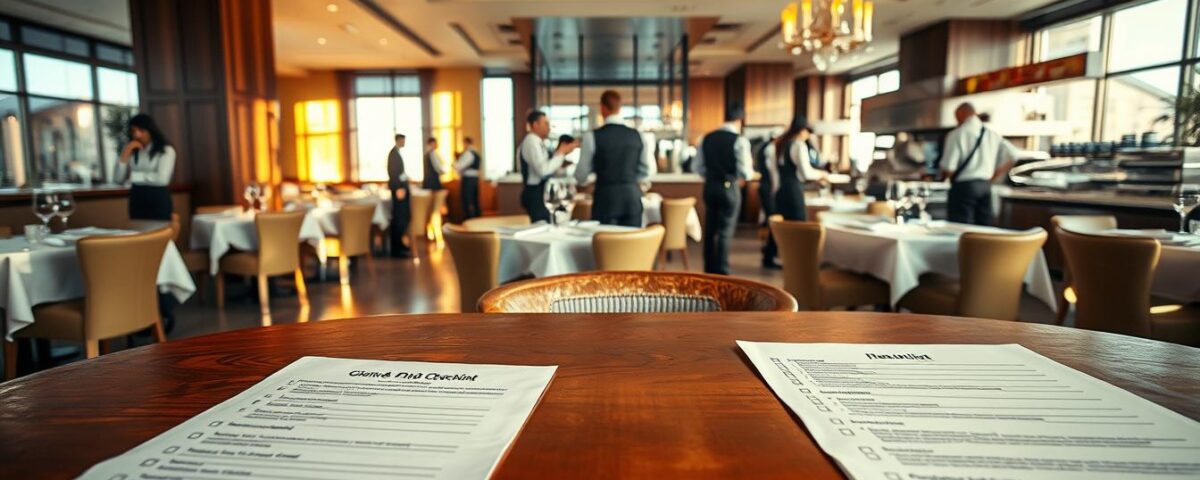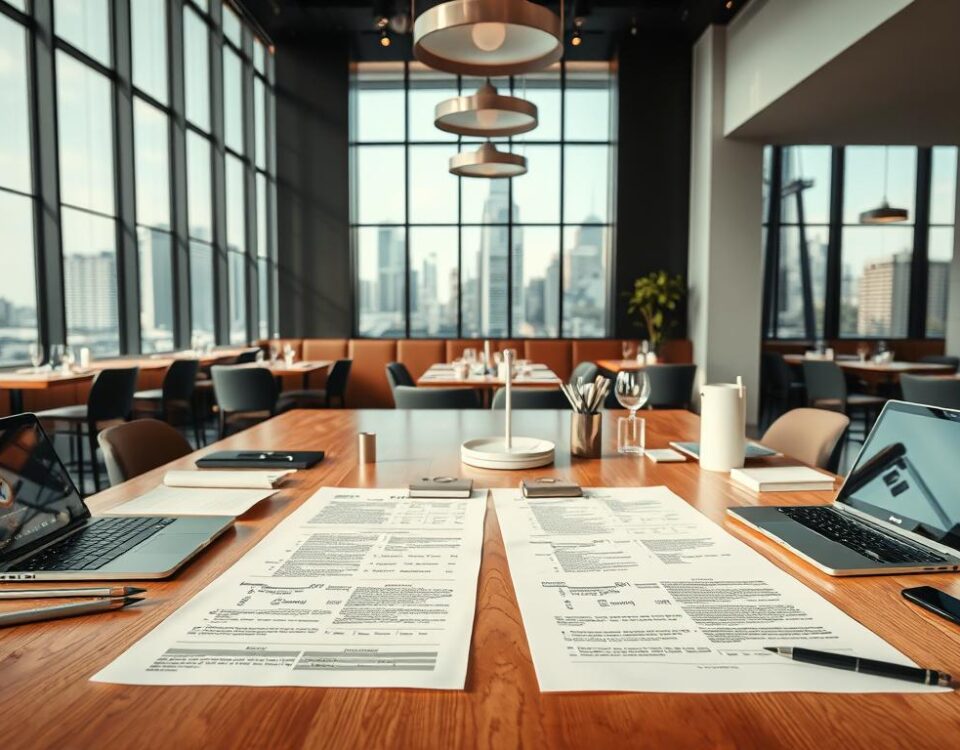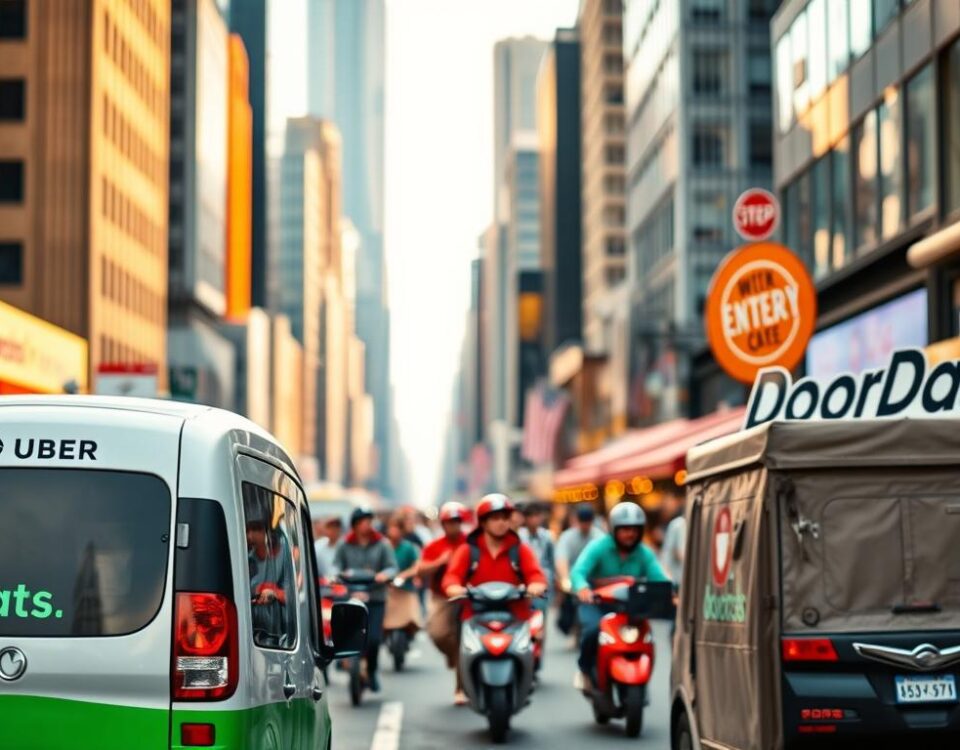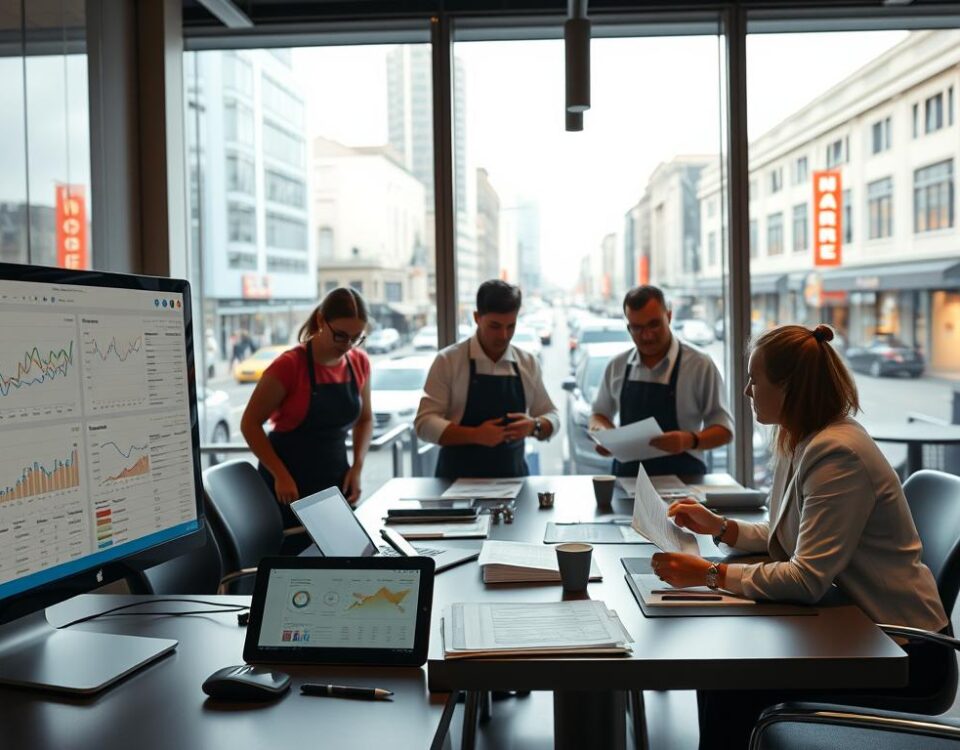
How to Start a Restaurant from Scratch: A Step-by-Step Launch Plan
October 13, 2025I’ve been through the restaurant opening process multiple times, and I know firsthand how overwhelming it can be to keep track of everything that needs to be done. From legal requirements to equipment purchases, the tasks can be daunting.
Did you know that a significant number of businesses fail due to poor planning? In fact, opening a restaurant involves hundreds of moving parts, and forgetting even one critical task can delay your grand opening.
That’s why I created this comprehensive checklist to help new owners navigate the complex journey from concept to opening day. By following this guide, you’ll be able to stay organized and confident as you transform your restaurant dream into a successful business reality.
Key Takeaways
- Create a detailed timeline for your restaurant opening process.
- Break down the planning process into manageable timeframes.
- Avoid common pitfalls that can cost you time and money.
- Stay organized with a comprehensive checklist.
- Ensure a successful business by following this guide.
Planning Your Restaurant Concept
Crafting a restaurant concept that stands out from the competition requires a deep understanding of your target audience and market trends. This involves a multi-step process that begins with defining your restaurant’s vision and brand identity.
Defining Your Restaurant’s Vision and Brand Identity
Defining your restaurant’s vision and brand identity is the foundation upon which all other decisions are made, from menu design to interior decor. It’s about creating a unique value proposition that differentiates your establishment from competitors. When defining your brand identity, consider elements such as logo design, color schemes, and the overall atmosphere you want to create.
Creating a Comprehensive Business Plan
A comprehensive business plan is crucial for the success of your restaurant. It should include detailed financial projections, startup costs, operational expenses, and revenue forecasts. This plan will serve as a roadmap for your restaurant’s development and help you secure funding if needed.
Conducting Market Research and Feasibility Studies
Conducting thorough market research and feasibility studies is essential to understanding your target audience and the local dining scene. This involves analyzing competitors, identifying gaps in the market, and assessing potential locations based on factors like foot traffic and accessibility.
By following these steps and using project management tools to track progress, you can ensure that your restaurant concept is well-planned and poised for success.
Legal Requirements and Documentation
Navigating the legal landscape is a critical step in opening a restaurant. Ensuring you comply with all legal requirements is crucial for a smooth operation and to avoid potential legal issues down the line.
Business Registration and Entity Formation
Determining the best business structure for your restaurant is the first legal step. This could be an LLC, corporation, or partnership, each with its own implications for liability protection and tax obligations. I always start by consulting with a legal expert to decide on the most suitable structure for my business needs.
Essential Permits and Licenses
Obtaining the necessary permits and licenses is critical for legal operation. This process begins with researching local health codes and regulations to understand the specific requirements for your area. My essential permits checklist includes a business license, food service license, liquor license (if applicable), sign permit, music license, and certificate of occupancy.
Insurance Coverage for Restaurants
Having the right insurance coverage is vital for protecting your restaurant from various risks. I work with an insurance broker who specializes in restaurants to ensure I have comprehensive coverage, including general liability, property insurance, workers’ compensation, and food contamination insurance.
By carefully handling these legal requirements and maintaining organized documentation, you can ensure your restaurant is well-prepared for a successful opening and ongoing operation.
Location and Design Planning
A well-planned location and design are the foundation upon which a thriving restaurant is built. When it comes to opening a new eatery, these two elements are crucial for attracting and retaining customers.
Finding the Perfect Location
I evaluate potential restaurant locations based on multiple factors: visibility, accessibility, parking availability, proximity to my target demographic, and the overall neighborhood vibe. Securing a location that scores well on these factors can significantly impact my restaurant’s success.
Restaurant Layout and Design Considerations
When designing my restaurant layout, I focus on creating efficient traffic flow between the dining area, kitchen, restrooms, and entrance/exit points to maximize both customer experience and staff productivity. I also consider the balance between seating capacity and customer comfort.
Working with Architects and Contractors
I work closely with architects who understand restaurant-specific requirements to ensure my design meets all building codes, ADA compliance, and functional needs. When selecting contractors, I look for those with specific restaurant construction experience who understand the unique challenges of commercial kitchen installation and restaurant design.
By carefully planning my restaurant’s location and design, I can create a welcoming area that attracts customers and sets my business up for success.
The Complete Restaurant Startup Checklist
After opening multiple restaurants, I’ve distilled my experience into a timeline-based checklist that covers all the essential tasks. This comprehensive guide will help you navigate the process of opening a restaurant, ensuring that you don’t miss any critical steps along the way.
Six Months Before Opening
At this stage, I focus on securing financing, finalizing the location, submitting architectural plans, and applying for major permits. Developing the initial concept and brand identity is also crucial during this period. It’s essential to lay a solid foundation to ensure the success of your restaurant.
3-4 Months Before Opening
During this period, I concentrate on ordering equipment with long lead times, applying for specialized licenses like liquor licenses, developing staff structure, and finalizing interior design plans. It’s also the right time to finalize graphic designs and branding initiatives, secure web and social domains, and order bar and kitchen equipment.
Some of the key tasks during this phase include:
- Applying for a liquor license if required
- Securing both web and social domains
- Ordering furniture for the restaurant
- Developing vision, mission, value, and culture statements
- Preparing operational strategies and deciding on operational vendors
60 Days Before Opening
My 60-day checklist includes installing exterior signage, launching initial marketing efforts, setting up payroll systems, ordering smallwares, interviewing management staff, and ensuring construction is on schedule. It’s a busy period that requires careful planning and execution.
Some critical tasks during this phase include:
- Installing exterior signage and executing the first portion of the marketing plan
- Creating a start-up menu and preparing food and beverage supply chain management
- Interviewing and onboarding key management staff
- Deciding on and ordering point-of-sale systems and other digital equipment
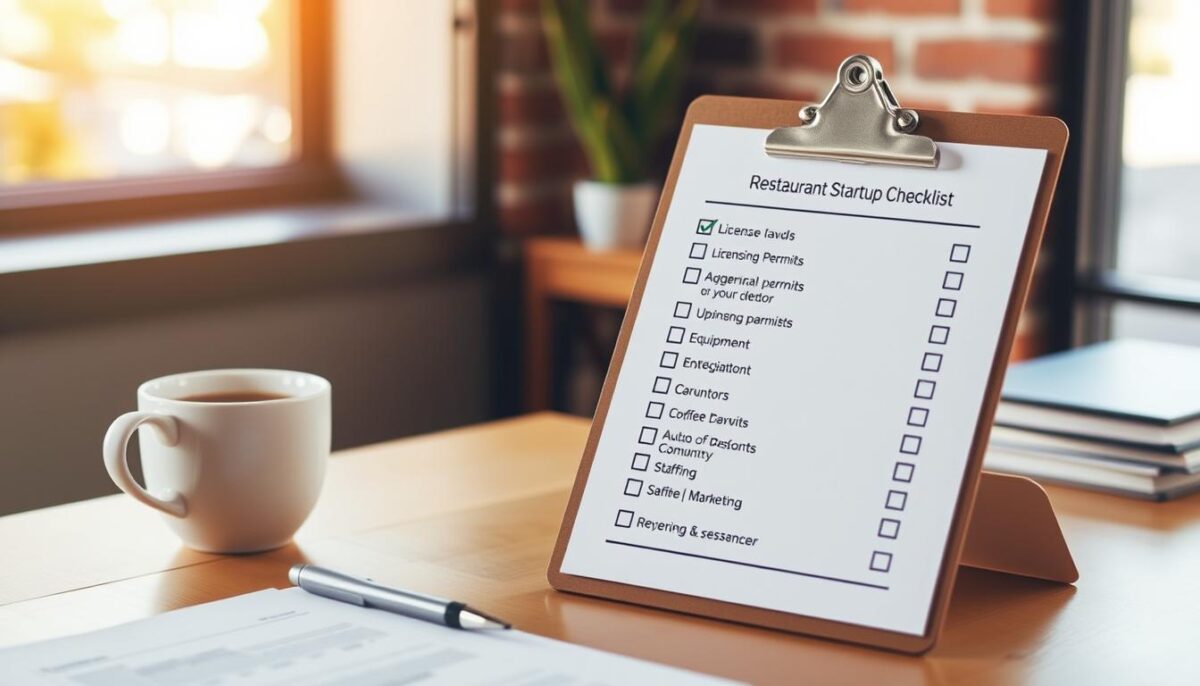
30 Days Before Opening
The 30-day countdown is critical. I install and test POS systems, finalize menus and recipes, begin staff training, order inventory for soft openings, and implement the final marketing push. It’s essential to stay focused and ensure that all tasks are completed on time.
Some of the key tasks during this phase include:
- Installing and testing POS systems and merchant services
- Finalizing recipe booklets and menu cards
- Beginning staff training and creating staff schedules
- Executing 30-day marketing and media launch strategies
By following this comprehensive checklist, you can ensure a smooth and successful restaurant opening. Remember to stay flexible and adapt to any changes or challenges that may arise during the process.
Equipment and Supply Procurement
The backbone of any restaurant lies in its equipment and supplies, making procurement a key task. As I plan my restaurant’s opening, I need to consider various elements that will ensure efficient operation and a great customer experience.
Essential Kitchen Equipment
When it comes to commercial kitchen equipment, the options can be overwhelming. To make informed decisions, I create detailed equipment lists categorized by kitchen area, such as cooking line, prep, dishwashing, and storage.
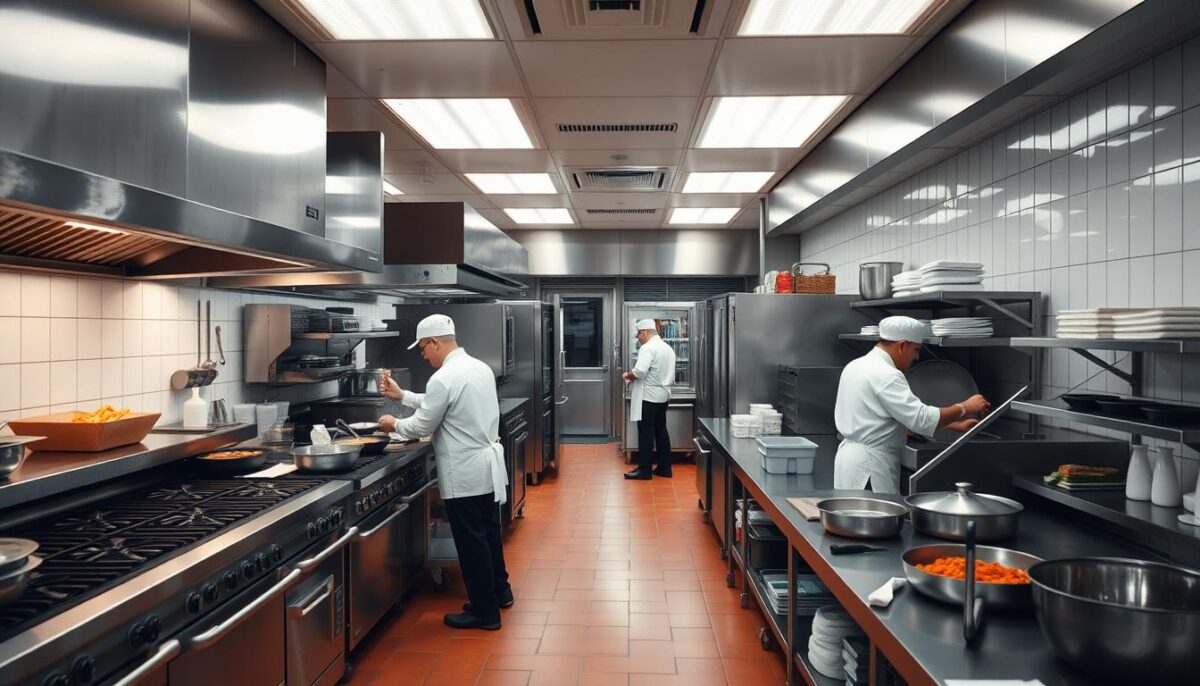
I consider not just the upfront cost but also energy efficiency, maintenance requirements, and warranty terms when purchasing major kitchen equipment. Prioritizing equipment with multiple functions, like combination ovens, helps maximize kitchen space and efficiency.
Front-of-House Furnishings and Supplies
For the front-of-house, I balance aesthetic appeal with durability and comfort. Restaurant furniture takes significant abuse and needs to withstand years of use. I order furniture that aligns with my restaurant’s concept, including tables, chairs, and umbrellas.
Technology and POS Systems
Deciding on the right POS systems and technology is crucial for streamlined operations. I test various systems extensively, focusing on ease of use for staff, integration capabilities with accounting software, and inventory management features.
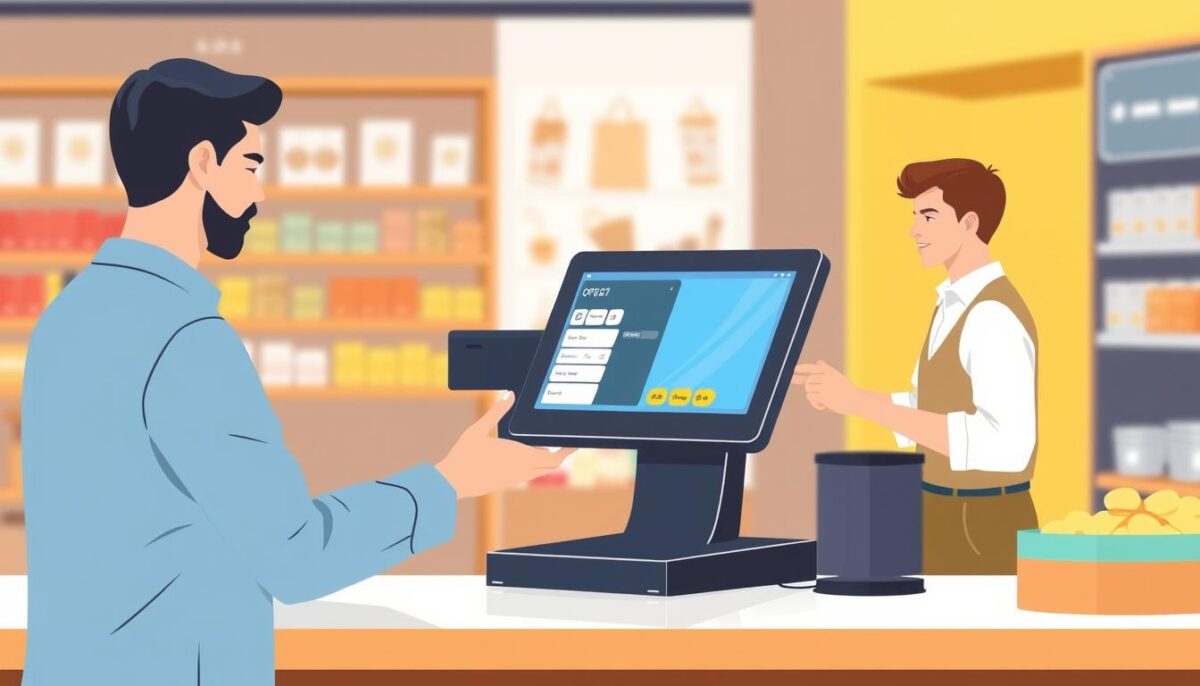
To avoid disruptions, I establish relationships with multiple suppliers for critical items. I also create a detailed smallwares inventory system from day one, implementing check-in/check-out procedures for expensive items to reduce loss.
Scheduling equipment installation in a logical sequence ensures that major installations are completed before bringing in expensive equipment that could be damaged during construction.
Menu Development and Food Operations
Crafting a menu that balances profitability and customer appeal is essential for any restaurant’s success. As a restaurant owner, I understand the importance of developing a menu that not only delights customers but also ensures the financial sustainability of the business.
Creating a Profitable Menu
When designing my menu, I analyze each item’s food cost percentage, preparation time, ingredient availability, and potential popularity to create a well-rounded offering. I implement menu engineering techniques to highlight high-profit items through strategic placement, descriptive language, and visual emphasis.
Sourcing Ingredients and Establishing Vendor Relationships
I establish relationships with multiple food vendors, comparing pricing, quality, delivery reliability, and payment terms before making commitments. This ensures that I source high-quality ingredients at competitive prices, ultimately benefiting my customers and the restaurant’s bottom line.
Implementing Food Safety Protocols
Implementing a robust food safety plan is crucial to preventing foodborne illnesses and ensuring a clean environment. My food safety protocols include comprehensive HACCP plans for high-risk items, detailed temperature logging procedures, and regular staff training. I also create standardized recipes with exact measurements, preparation methods, plating instructions, and photos to ensure consistency across dishes.
By focusing on menu development, sourcing quality ingredients, and maintaining stringent food safety standards, I can ensure that my restaurant delivers a consistently high-quality dining experience while maintaining profitability.
Building Your Restaurant Team
Creating a cohesive and talented team is essential for my restaurant’s launch and long-term success. As I prepare to open my doors, I focus on building a strong staff that can deliver exceptional dining experiences.
Hiring and Onboarding Staff
I start by hiring key management positions, such as a general manager and chef, at least 60 days before opening. This allows them to be involved in critical decisions and training development. My hiring process includes practical skills assessments alongside traditional interviews to ensure the right fit for my restaurant.
- I involve key management in the hiring process to ensure cultural fit.
- Practical skills assessments help evaluate potential staff members.
- I create detailed training manuals for each position.
Training Programs for Different Positions
I develop comprehensive training programs that include technical skills, brand standards, and service philosophy. Employee training is crucial for delivering consistent service and ensuring that my team is equipped to handle various situations.
- Training includes menu tastings and service rehearsals.
- I implement cross-training programs to create a flexible team.
- Regular staff meetings ensure everyone is aligned and informed.
Creating a Positive Work Culture
Fostering a positive culture is vital for employee satisfaction and retention. I communicate my restaurant’s values and goals clearly and encourage an environment where every team member feels valued.
- I establish clear communication channels from day one.
- Recognition programs and performance incentives celebrate team successes.
- I develop career advancement paths to retain talented staff.
By focusing on staff development and creating a positive culture, I set my restaurant up for success. A well-trained and motivated team is key to delivering exceptional customer experiences and driving long-term growth.
Conclusion: Your Restaurant’s Grand Opening
The grand opening of your restaurant is not just a milestone; it’s a culmination of careful planning and execution. By now, you’ve laid the groundwork, and it’s time to ensure that every aspect of your restaurant is ready for the first guests on the opening day.
A successful grand opening requires more than just a great concept; it demands meticulous attention to detail. I always plan a soft opening period of 1-2 weeks to test operations and train staff. On opening day, arriving early to ensure the restaurant is spotless and all systems are functioning is crucial.
- Create a detailed checklist for opening day to cover all aspects, from supplies to staff preparedness.
- Prepare your team for the unexpected by discussing potential scenarios and solutions.
- Make yourself visible on opening day, greeting guests and gathering feedback.
By following these steps and staying focused on time-sensitive tasks, you’ll be well on your way to a successful restaurant opening, achieving the success you’ve worked hard for.
FAQ
What are the most important things to consider when planning my restaurant’s concept?
When planning my restaurant’s concept, I need to define my vision and brand identity, create a comprehensive business plan, and conduct market research and feasibility studies to ensure my concept is viable and meets the needs of my target audience.
What kind of permits and licenses do I need to open my restaurant?
To open my restaurant, I need to obtain essential permits and licenses, such as a food service permit, business license, and liquor license if I plan to serve alcohol. I should check with my local government to determine the specific requirements for my area.
How do I ensure food safety in my restaurant?
To ensure food safety, I need to implement protocols such as proper food handling and storage, regular cleaning and sanitizing, and training my staff on food safety procedures. I should also consider implementing a HACCP plan to identify and control potential hazards.
What kind of equipment do I need to purchase for my restaurant’s kitchen?
For my restaurant’s kitchen, I need to purchase essential equipment such as commercial cooking appliances, refrigeration units, and dishwashing equipment. I should also consider the specific needs of my menu and concept when selecting equipment.
How do I create a positive work culture in my restaurant?
To create a positive work culture, I need to focus on hiring and onboarding staff who share my vision and values, provide ongoing training and development opportunities, and foster a positive and inclusive work environment. I should also recognize and reward my staff for their hard work and contributions.
What is the importance of having a comprehensive business plan for my restaurant?
A comprehensive business plan is crucial for my restaurant’s success as it outlines my goals, target market, financial projections, and marketing strategy. It helps me stay focused and on track, and makes it easier to secure funding and make informed decisions.
How do I choose the right POS system for my restaurant?
When choosing a POS system, I need to consider factors such as ease of use, functionality, and compatibility with my existing systems. I should also look for a system that provides features such as inventory management, employee management, and analytics to help me optimize my operations.
